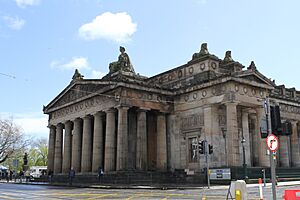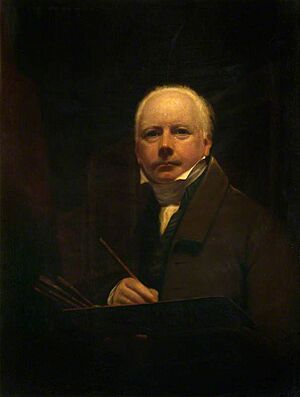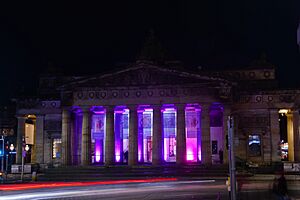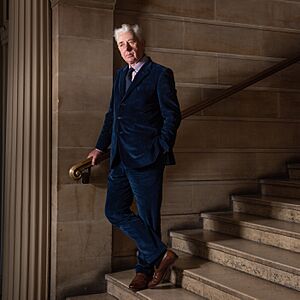Royal Scottish Academy facts for kids
 |
|

The RSA Building on Princes Street, Edinburgh
|
|
| Abbreviation | RSA |
|---|---|
| Formation | May 27, 1826 |
| Founded at | Edinburgh |
| Purpose | Supporting art and architecture in Scotland |
| Headquarters | Royal Scottish Academy Building, The Mound, Edinburgh, EH2 2EL |
| Location |
|
| Origins | Secession from the Royal Institution, 1826 |
|
Region served
|
Scotland |
| Fields | Fine Arts |
|
Director
|
Colin Greenslade |
|
President
|
Gareth Fisher |
The Royal Scottish Academy (RSA) is Scotland's national art academy. It helps to promote and support modern Scottish art.
A group of eleven artists started the Academy in 1826 in Edinburgh. It was first called the Scottish Academy. It became the Royal Scottish Academy in 1838. This happened when it received a special permission called a royal charter.
The RSA is unique in Scotland. It is run by famous artists and architects. It is funded independently. Its main goal is to support and share art. It does this through exhibitions and educational events.
Contents
History of the RSA
How the Academy Began
The Royal Institution for the Encouragement of the Fine Arts in Scotland (RI) started in 1819. Its goal was to hold art shows. It also wanted to help people appreciate art in Scotland. The RI bought artworks by Scottish artists. It also collected many old master paintings.
A new building was built for the RI in Edinburgh. It was designed by William Henry Playfair. This building was at the corner of The Mound and Princes Street. The RI shared this building with other groups. These included the Royal Society of Edinburgh and a museum.

Some artists felt the RI was too exclusive. So, in 1826, a group of artists left the RI. They formed their own group. They called it the Scottish Academy of Painting, Sculpture, and Architecture.
Their first meeting was on May 27, 1826. It took place in Edinburgh. Thirteen artists attended. This included 11 painters, one architect, and one sculptor. George Watson was their first president. He served until 1837.
Goals of the New Academy
The new Academy had several important goals:
- To hold an art show every year. This show would be open to all good artists.
- To offer free art education. They wanted to create an academy for fine arts.
- To build a collection of artworks and an art library.
- To help artists who were struggling financially.
The RSA's first annual exhibition was held in rented rooms. In 1835, they rented gallery space in the Royal Institution building. They used this space to show their growing art collection. In 1838, they received a royal charter. This is when they officially became the Royal Scottish Academy (RSA).

Finding a Permanent Home
One of the RSA's main goals was to create a national art gallery for Scotland. This goal was achieved in 1859. A new gallery building was built by Playfair. It was called the National Gallery of Scotland. It was right next to the RI building.
This new building housed the RI's collection of old master paintings. It also held the RSA's collection. The RSA continued to share space in the National Gallery building until 1911.
Around the early 1900s, many art groups moved. The Society of Antiquaries moved its museum. The Royal Society moved to George Street. In 1907, the Royal Institution moved to the new Edinburgh College of Art.
Finally, in 1911, the RSA was given permanent use of the old RI building. They also got the right to hold their annual exhibition there. This building then became known as the Royal Scottish Academy. It still has this name today.
What the RSA Does
The RSA holds many art exhibitions throughout the year. They also offer scholarships and awards. These help artists who live and work in Scotland. They also provide places for artists to stay and work.
The RSA has a large collection of important artworks. They also have many historical documents. These tell the story of art and architecture in Scotland for over 180 years. This collection is kept at the National Museums Collection Centre. Researchers can visit it by appointment. Sometimes, parts of the collection are put on display.
The most famous award given by the RSA is the Guthrie Award. This award has been given to Scottish artists every year since 1920. There are also many other awards. These include the Keith Award, the Latimer Award, and various architecture awards.
The RSA Building
Since 1911, the RSA's home has been the Royal Scottish Academy Building. It is located where The Mound meets Princes Street in Edinburgh. It is right next to the National Gallery of Scotland building.
National Galleries Scotland manages the RSA building. However, the RSA has permanent offices there. They also share exhibition space throughout the year. Other art groups also use the space. The building was designed by William Henry Playfair. It was recently updated as part of the Playfair Project. It is now part of the Scottish National Gallery complex.
Academicians: The Members of the RSA
The RSA is led by a group of important artists and architects. These members are called Academicians. They represent many different types of modern Scottish art. When they are members, they can use the letters RSA after their name.
The president of the RSA uses the letters PRSA while in office. After their term, they use PPRSA (Past President of the RSA).
Academicians are chosen by other members. There are also Honorary Academicians (HRSA). Since 2005, new members (called Associates, ARSA) become full members. This happens after they give a special artwork to the RSA's permanent collection.
The RSA currently has 30 Honorary Academicians. It also has 104 Academicians. From 2010 to 2012, Professor Bill Scott was the RSA President. In 2018, Joyce W. Cairns became the first female President. The current RSA President is Gareth Fisher.
Past Presidents of the RSA
- 2022–present: Gareth Fisher
- 2018–2022: Joyce W. Cairns
- 2012–2018: Arthur Watson
- 2007–2012: Bill Scott
- 1998–2007: Ian McKenzie-Smith
- 1990–1998: William James Laidlaw Baillie
- 1983–1990: Sir Anthony Wheeler
- 1973–1983: Sir Robin Philipson
- 1964–1973: N/A
- 1959–1964: Sir William MacTaggart
- 1950–1959: William Oliphant Hutchison
- 1944–1950: Sir Frank Mears
- 1933–1944: Sir George Pirie
- 1923–1933: Sir George Washington Browne
- 1919–1923: Sir J. Lawton Wingate
- 1902–1919: Sir James Guthrie
- 1891–1902: Sir George Reid
- 1882–1891: Sir William Fettes Douglas
- 1876–1882: Sir Daniel Macnee
- 1864–1876: Sir George Harvey
- 1850–1864: Sir John Watson Gordon
- 1837–1850: Sir William Allan
- 1826–1837: George Watson (first president)
See also
 In Spanish: Real Academia Escocesa para niños
In Spanish: Real Academia Escocesa para niños
- Royal Society of Edinburgh
- Royal Academy of Arts
- Royal Society of Arts
- Royal West of England Academy
- John James Bannatyne



